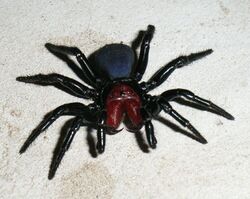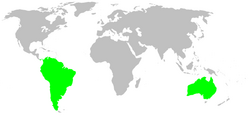Biology:Actinopodidae
| Actinopodidae | |
|---|---|

| |
| M. occatoria, male | |
| Scientific classification | |
| Domain: | Eukaryota |
| Kingdom: | Animalia |
| Phylum: | Arthropoda |
| Subphylum: | Chelicerata |
| Class: | Arachnida |
| Order: | Araneae |
| Infraorder: | Mygalomorphae |
| Clade: | Avicularioidea |
| Family: | Actinopodidae Simon, 1892 |
| Genera | |
|
3, see text | |
| Diversity | |
| 3 genera, 124 species | |

| |
Actinopodidae is a family of mygalomorph spiders found in mainland Australia and South America usually in open forest. Species are most common in Queensland, Australia.[1] It includes mouse spiders (Missulena species), whose bites, though rare, are considered medically significant and potentially dangerous.[2]
Description
Actinopodidae has wider vision then most other Australian mygalomorphs and have a wide front to their carapace.[3] Members of the family are stout black with species size varying from 10 mm-35 mm in length. Species have distinctively bulbous heads and jaw regions. They are oftentimes confused with funnel-web spiders. Depending on the species, the abdomen is black or dark blue with a light grey to white patch top. Legs are dark and may appear thin and the head is shiny black. Female of the family are stockier and larger.[4]
Burrow
They live in soil covered burrows with a hinged top. Burrows can extent to a depth of 30 cm (12 inches). The purpose of the burrow is for refuge from predators, temperature control and parasites. Male spiders will wander away from the burrow in search for female spiders for mating while females stay in the burrow for most of their life.[5]
Diet
Species of Actinopodidae are ambush hunters that lie in their burrow lid at night preying on insects that are within catching range.
Genera
(As of April 2019), the World Spider Catalog accepts the following genera: [6]
- Actinopus Perty, 1833 — South America
- Missulena Walckenaer, 1805 — Australia, Chile
- Plesiolena Goloboff & Platnick, 1987 — Chile
See also
References
- ↑ Museum, c=AU; co=Queensland Government; ou=Queensland. "Mouse Spiders". https://www.qm.qld.gov.au/Explore/Find+out+about/Animals+of+Queensland/Spiders/Primitive+Spiders+Infraorder+Mygalomorphae/Mouse+Spiders.
- ↑ Isbister, Geoffrey K. (2004). "Mouse spider bites (Missulena spp.) and their medical importance". Med J Aust 180 (5): 225–227. doi:10.5694/j.1326-5377.2004.tb05890.x. https://www.mja.com.au/journal/2004/180/5/mouse-spider-bites-missulena-spp-and-their-medical-importance.
- ↑ "ACTINOPODIDAE Mouse Spiders". http://www.arachne.org.au/01_cms/details.asp?ID=2427.
- ↑ "Mouse Spiders" (in en). https://australian.museum/learn/animals/spiders/mouse-spiders/.
- ↑ "Mouse Spider - Facts, Venom & Habitat Information" (in en-US). https://animalcorner.org/animals/mouse-spider/.
- ↑ "Family: Actinopodidae Simon, 1892". Natural History Museum Bern. http://www.wsc.nmbe.ch/family/1.
External links
Wikidata ☰ Q5845 entry
 |

